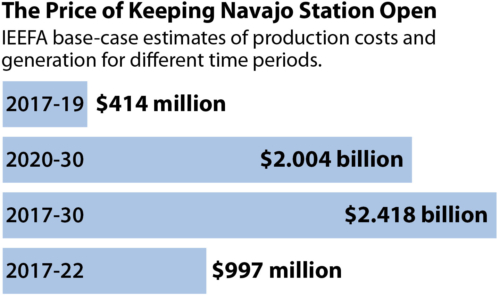Why Navajo Generating Station Is No Longer Commercially Viable

The Institute for Energy Economics and Financial Analysis (IEEFA) has done extensive research into the difficult circumstances facing Navajo Generation Station.
- Declining energy market prices and rising production costs have made power produced by the plant more expensive than competing sources.
- Market trends are not likely to change, leaving the plant’s financial viability in doubt regardless of who owns it.
- The subsidized cost of keeping the plant running from mid-2017 through the end of 2019 will total about $414 million. A five-year bailout plan through mid-2022, as has been suggested, would cost $740 million to $1 billion. Keeping it running until 2030 would require subsidies of $1.4 billion to $2.4 billion.
Kayenta Mine
IEEFA has concluded also that Kayenta mine in is not likely to find new customers or markets once its sole customer, Navajo Generating Station, closes. The same market conditions that are causing Navajo Generating Station to close have led to the announced retirements of at least 2,500 additional megawatts of coal-fired power in the Southwest.
 Coal production at mines in the Southwest U.S. is declining. Production at 20 of the largest coal mines in the four-state region of Arizona, Colorado, New Mexico and Utah decreased from 66 million tons in 2014 to 45 million tons in 2016, a 32 percent decline. Production at Peabody Energy’s three mines in the region (Kayenta, El Segundo (in New Mexico) and Twentymile (in Colorado) dropped from 23 million tons in 2014 to 12.8 million in 2016, a 44 percent decrease.
Coal production at mines in the Southwest U.S. is declining. Production at 20 of the largest coal mines in the four-state region of Arizona, Colorado, New Mexico and Utah decreased from 66 million tons in 2014 to 45 million tons in 2016, a 32 percent decline. Production at Peabody Energy’s three mines in the region (Kayenta, El Segundo (in New Mexico) and Twentymile (in Colorado) dropped from 23 million tons in 2014 to 12.8 million in 2016, a 44 percent decrease.
Prudent Transition Now
While some politicians have called for federal subsidies to keep the plant running, IEEFA sees funds far better spent on a forward-looking transition plan that would help the Navajo Nation and the State of Arizona turn the page on this aging coal plant and its supporting mine.
IEEFA, in partnership with the Navajo Nation-based Diné Innovative Network of Economies in Hózhó (DinéHózhó L3C), has proposed a transition initiative that includes:
- Adoption of a framework that offers a clear structure for long-term growth based on local entrepreneurial, labor and organizational assets and that addresses the immediate needs of existing businesses that will lose customers and revenue from the plant and mine, and new large-scale projects in renewable energy and infrastructure.
- Guarantees of new jobs for 643 workers who will be laid off from the plant and mine and for others employed by supporting businesses.
- Fiscal support totaling $55 million in annual replacement revenues for the Navajo Nation and Hopi Tribes for at least five years.
- Professional administration of a transition initiative with an annual budget of $3.5 million overseen by a board that includes members of tribal governments, Arizona business leaders, federal government representatives, and employee leaders.
Full report “Why Navajo Generating Station Is No Longer Commercially Viable”
IEEFA’s reports on the Navajo Generating Station can be found at https://ieefa.org/category/subject/navajo-generating-station/
Contact: Karl Cates, IEEFA Media Relations, [email protected], (216) 714-3332












